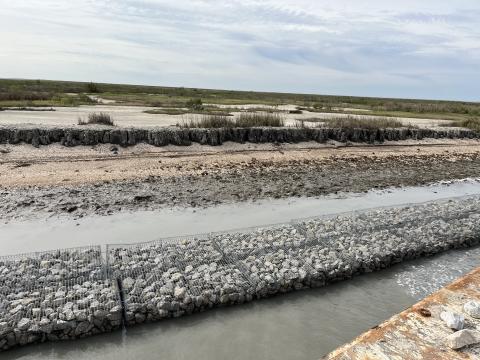The Louisiana Trustees have created a multifaceted restoration project benefitting both bird and oyster habitat within Calcasieu Lake in Cameron Parish, Louisiana. The recent addition of shoreline protection structures to the Rabbit Island Restoration Project has made a great project even better. To achieve this success, two local stakeholders, The Nature Conservancy and Cheniere Energy, LLC, joined forces with the Trustees.
In late December 2023, the Trustees completed the installation of 810 large wire mesh baskets filled with limestone rock along the northeastern edge of Rabbit Island. These 3,000-pound gabion baskets now form a protective barrier that is intended to limit the impacts of erosion and storm surge and create a wall-like structure behind which silt can collect, and vegetation can become established. The baskets of limestone rock will provide a proven substrate for oyster larvae, or spat, to attach to. Additional benefits arising from the installation of this very simple but substantial structure are likely to lead to the creation of marsh habitat for fish, birds, shellfish, marine mammals, and other wildlife, as well as expanded recreational fishing opportunities for the public. Once the marsh habitat behind the gabions is well established, it will, along with the filter-feeding oysters, help to improve water quality.
The Nature Conservancy (TNC), a nationwide environmental non-profit, provided invaluable support to the addition of the gabions to the Rabbit Island Restoration project through in-kind services and advice. TNC has years of expertise in oyster reef restoration, and provided the project team with advice on gabion basket design, material costing, and installation on Calcasieu Lake. This project is expected to generate direct benefits for the state’s Tier 1 public oyster reef located around significant portions of the island. Tier 1 oyster areas are the most ecologically sensitive, publicly owned, highly productive, and have little or no oil and gas activity.
Cheniere Energy, LLC has partnered with the Coastal Conservation Association’s national habitat program to invest in Louisiana’s newest Artificial Reef Program in Cameron Parish. For this project, Chenier provided $120,000 for the materials to build the gabion baskets.
Rabbit Island is the only brown pelican colony in southwestern Louisiana and represents one of only 10 remaining historic brown pelican colonies in the state. Restoring bird habitat at Rabbit Island to partially address injuries to birds caused by the Deepwater Horizon oil spill was an important goal that was featured prominently within the Louisiana Trustees’ initial restoration plan.
Recognizing that wind-generated waves, periodic high tides, and the effects of traffic in the Calcasieu Ship Channel had slowly eroded the shoreline of Rabbit Island, the Trustees began their restoration journey with the approval of the Natural Damage Assessment restoration project in 2020. At the time, the island had lost 89 acres of landmass, or 35% of its area, with the majority of its 200-acre footprint being open water. The settlement-funded restoration activity utilized dredged sediment from the Calcasieu Ship Channel to restore the elevation of the island. As a result, 102 acres of nesting bird habitat were restored, which included 81 acres of colonial waterbird nesting habitat and 21 acres of secretive marsh bird nesting habitat. More than 65,000 plants were installed, including smooth cordgrass, matrimony vine, groundsel bush, and marsh elder.
The restored island and its plantings have enhanced nesting habitat for brown pelicans, egrets, herons, ibis, terns, and skimmers, among many others. Rabbit Island’s first nesting season following restoration far exceeded expectations. Experts expected approximately 370 nests in the first year; however, in total, more than 11,600 colonial waterbird nests, of which 561 were brown pelican nests, were noted.
With the addition of the gabions and the protection and habitat improvements they are expected to provide, future nesting seasons on Rabbit Island appear headed for repeated success.


